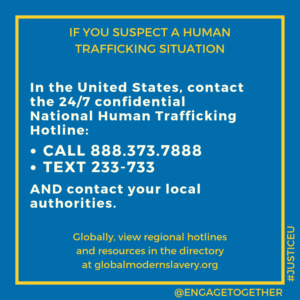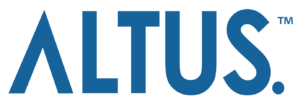By June of 2018, the National Human Trafficking Hotline had received over 14,000 calls, with over 5,000 cases of human trafficking reported in the United States.
As AWARENESS of human trafficking grows, it is critically important to know how to identify a potential case of human trafficking in your local community (or abroad) and to know what to do when you suspect something is wrong. Everyone is in a position – in their everyday activities of commuting, eating out, traveling, shopping, and more – to identify and report.
The AFRJ® breaks Identification into two categories that must be active in every community for identification efforts to be effective: training and outreach. Those most likely to be in contact with victims – such as law enforcement officers, health care providers, teachers, parents, service industry workers, and others – need profession-specific training to properly identify and detect a case of trafficking. Additionally, proactive outreach to vulnerable populations is also essential in identifying trafficking operations and rescuing victims.
Training. It is important to know that training and awareness are equally important but also different. Awareness is often general while training is profession-specific, with terminology and indicators unique to that sector or field. Training is also often offered by or in conjunction with a professional in the same field to provide peer-to-peer expertise and experience.
In addition to learning the indicators of human trafficking, it is also critical in a training to understand the protocols that are in place. Protocols will vary by profession and sector and are an essential element to training so that each individual knows what to do, who to contact, what forms to fill out, what their organization policy is, and more to ensure information is received and effectively acted on.
Profession and sector-specific training that needs to be offered in communities includes information for medical professionals, law enforcement, teachers, social workers, buses, trucking, service industry, and more.
Outreach. Proactive outreach to vulnerable populations is essential in efforts to both prevent and identify human trafficking, and this can take place in many different ways. Community members can come alongside organizations already serving vulnerable populations to provide additional support. Local experts can educate participants in outreach programs, such as those reaching out to homeless populations, at-risk children and youth, refugees, jails, detention centers, courts, or commercial sex industry to spot and report suspicious activity. Coalitions and task forces can provide information at special events or venues in the community such as sports events, holiday outreaches, state and county fairs, mall outreaches, and others.
Serving those in need in your community may directly lead to identifying trafficking operations and rescuing individuals in harm’s way. This month, take time to learn what trainings are available for the sectors you work in or engage with both professionally and personally. Share with your network about specific trainings to help equip your community to identify and report.
Through specific trainings and community outreach efforts, human trafficking can be IDENTIFIED, victims rescued, and perpetrators brought to justice.

- Sign up for Engage Together® emails sent right to your inbox
- Visit www.enagetogether.com/myrole for immediate ways to engage

